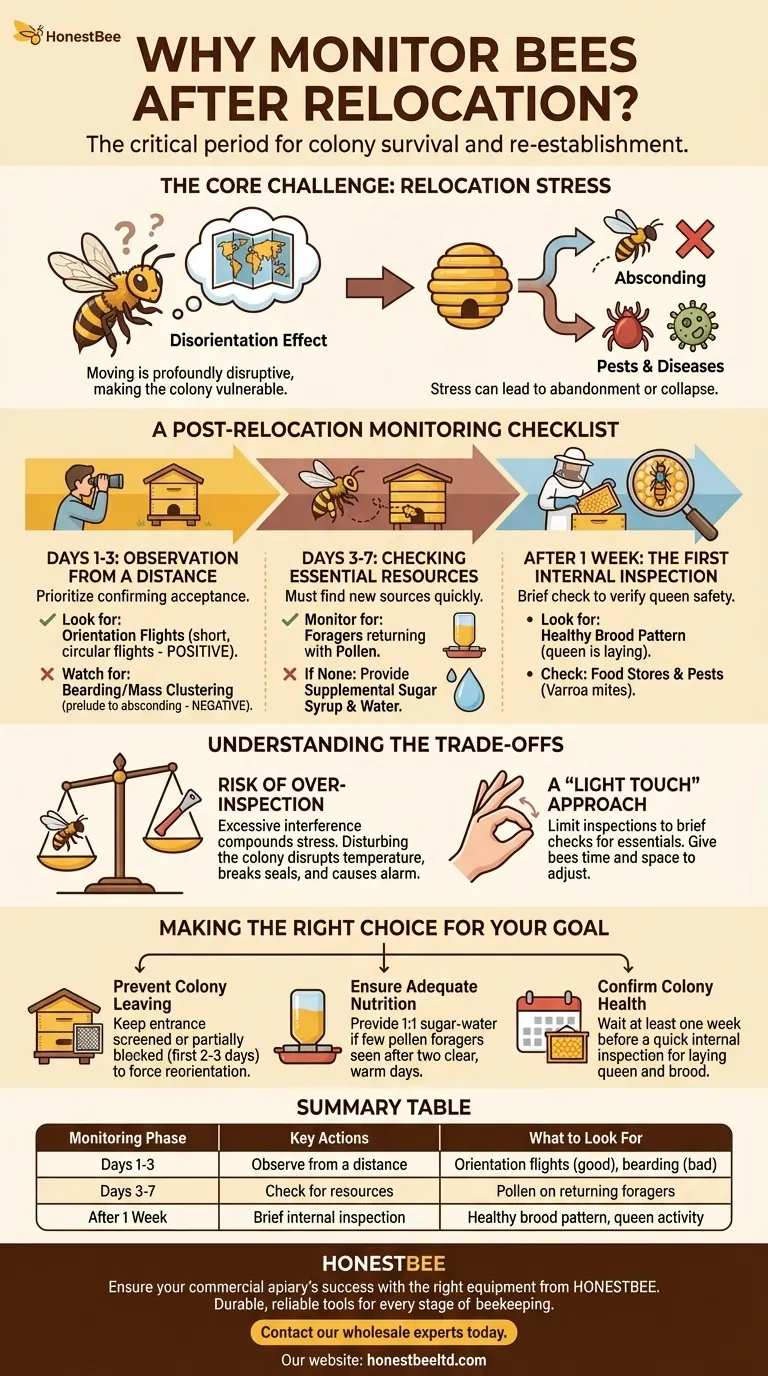Relocating a beehive is not the end of a job, but the beginning of a critical observation period. Monitoring is essential because the immense stress of a move makes a colony highly vulnerable to disorientation, starvation, and disease. Without careful observation in the days and weeks that follow, the entire colony could abandon the hive or collapse.
Relocation fundamentally resets a colony's map of its world, causing significant stress. Your primary goal in monitoring is to ensure the bees can successfully reorient themselves, find new resources, and re-establish their internal routines without succumbing to post-move vulnerabilities.

The Core Challenge: Relocation Stress
A beehive is a complex, place-based superorganism. Moving it is profoundly disruptive and induces a state of high stress that can trigger a cascade of problems.
The Disorientation Effect
Bees navigate with incredible precision, memorizing the exact location of their hive and surrounding floral resources. Relocation makes this internal GPS obsolete.
Imagine being moved to a new city in your sleep. You would wake up confused, unable to find food, and desperate to get back to familiar territory. This is what a relocated bee experiences.
The Cascade of Vulnerabilities
This initial disorientation leads to several immediate threats to the colony's survival.
Stressed bees may attempt to abscond, abandoning the new hive location entirely. Their weakened state also makes them more susceptible to pests and diseases that a healthy colony could normally fight off.
A Post-Relocation Monitoring Checklist
Your monitoring should be phased, starting with non-intrusive observation and moving toward a more detailed inspection only when necessary.
Days 1-3: Observation from a Distance
Your first priority is to confirm the bees are accepting the new location. Stay back and watch the hive entrance.
Look for bees performing orientation flights—short, circular flights in front of the hive as they map their new surroundings. This is a positive sign. Conversely, watch for "bearding" or mass clustering at the entrance, which could be a prelude to absconding.
Days 3-7: Checking Essential Resources
The bees' known food and water sources are now gone. They must find new ones quickly.
Monitor the entrance for foragers returning with pollen on their legs. If you see little to no pollen coming in after a few good foraging days, the colony is struggling. Be prepared to provide supplemental sugar syrup and a water source to prevent starvation and dehydration.
After 1 Week: The First Internal Inspection
After giving the colony about a week to settle, you can perform a quick internal inspection. The goal is to verify the queen is safe and the colony is functioning.
Look for a healthy brood pattern, which indicates the queen is laying. Check their food stores. If they are low, continue supplemental feeding. This is also a good time for a quick check for pests like varroa mites.
Understanding the Trade-offs: The Risk of Over-Inspection
While monitoring is crucial, excessive interference can compound the colony's stress and do more harm than good.
Disturbing a Stressed Colony
Every time you open a hive, you disrupt its temperature, break propolis seals, and cause alarm. For a colony already on edge from a move, frequent inspections can increase their agitation and slow their recovery.
A "Light Touch" Approach
For the first week, your most valuable tool is patient observation from a distance. Limit internal inspections to brief, targeted checks for essentials. Give the bees the time and space they need to adjust on their own terms.
Making the Right Choice for Your Goal
Your actions should be a direct response to what you observe. Use this as a guide for common post-relocation scenarios.
- If your primary focus is preventing the colony from leaving: Keep the entrance screened or partially blocked with branches for the first 2-3 days to force reorientation.
- If your primary focus is ensuring adequate nutrition: Provide a 1:1 sugar-water feeder if you don't see foragers bringing back pollen after two clear, warm days.
- If your primary focus is confirming colony health: Wait at least one week before a quick internal inspection to check if the queen is laying and brood patterns are normal.
By carefully monitoring your bees after a move, you guide them through a difficult transition and ensure their long-term health and productivity.
Summary Table:
| Monitoring Phase | Key Actions | What to Look For |
|---|---|---|
| Days 1-3 | Observe from a distance. | Orientation flights (good), bearding (bad). |
| Days 3-7 | Check for resources. | Pollen on returning foragers. |
| After 1 Week | Brief internal inspection. | Healthy brood pattern, queen activity. |
Ensure your commercial apiary's success with the right equipment from HONESTBEE.
Relocating hives is a high-stakes operation. Proper monitoring is essential, but it starts with having durable, reliable equipment that minimizes stress on your colonies. HONESTBEE supplies commercial apiaries and beekeeping equipment distributors with the high-quality tools needed for every stage of beekeeping, from secure transport to post-move health checks.
Let us help you build a more resilient and productive operation. Contact our wholesale experts today to discuss your equipment needs.
Visual Guide

Related Products
- Plastic Transporting Bee Packages and Nuc Boxes for Beekeeping
- 5 Frame Wooden Nuc Box for Beekeeping
- Twin Queen Styrofoam Honey Bee Nucs Mating and Breeding Box
- Portable Bee Mating Hive Boxes Mini Mating Nucs 8 Frames for Queen Rearing
- Automatic Heat Preservation 6 Frame Pro Nuc Box for Honey Bee Queen Mating
People Also Ask
- What are the benefits of starting a new bee colony in a nuc box? Boost Colony Success with Efficient Beekeeping
- How many frames does a typical wooden nuc box hold? A Guide to Choosing the Right Size
- What are the two main ways to obtain a queen bee when starting a new hive? Choose the Right Start for Your Apiary
- What is the method for making several smaller nuclei from a single colony? Accelerate Apiary Growth with the Split Technique
- How should a nucleus colony (nuc) be transported safely? A Guide to Minimizing Bee Stress



















